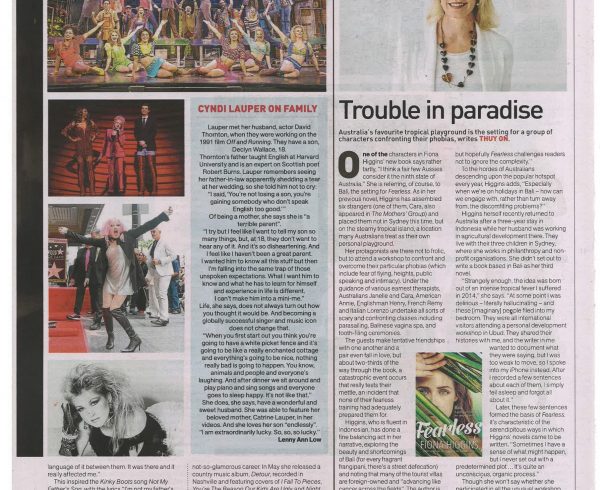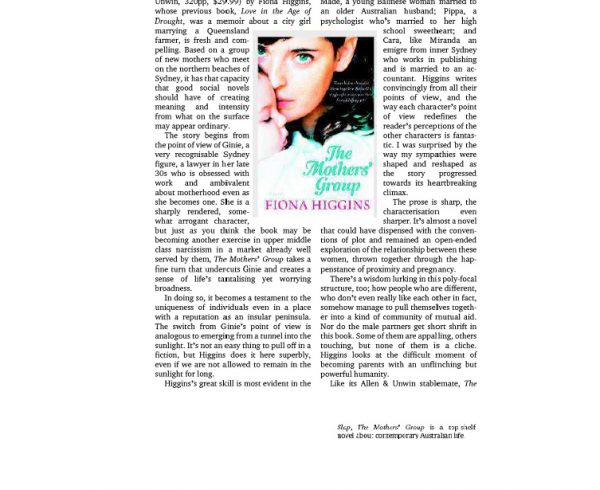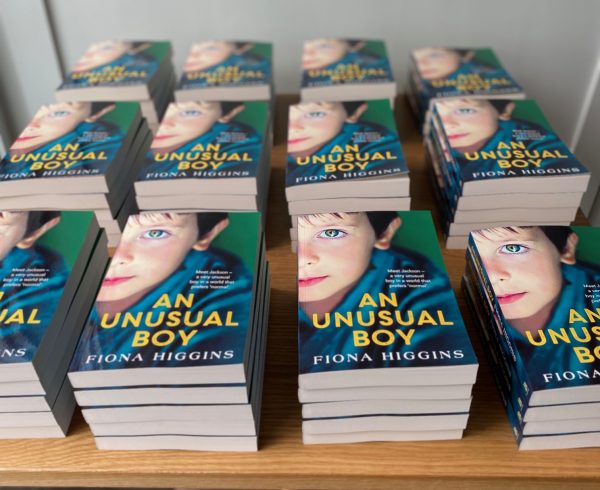Read Fiona’s latest article featured on Mamamia below or to see the full article on the Mamamia website click here.
Everyone’s a bit unusual,’ my mother used to tell me as a child, ‘but some are more unusual than others.’
Growing up, I was a slightly quirky kid; I had an over-active, intrusive imagination. My sense of difference was masked by decoding other children’s social cues, by writing poetry and by non-stop book reading. I was an ‘unusual girl’, or at least, I felt that way.
My mother wasn’t worried – after all, my hyper-focus on academics was a socially acceptable kind of unusual. It’s not something I talk about much, even now, as the experience was uncomfortable. I suspect I’ve channelled some of that into my latest novel, An Unusual Boy.
My sense of being ‘different’ as a child extended well beyond myself. At an early age, I learned how ‘unusual’ my home environment was compared to most of my peers; I was part of a family who cared for a disabled, neurodivergent father.
Over twenty years, I watched my father lose his skills, develop prominent dementia and regress from a walking stick to a wheelchair to institutionalised confinement. While my father doesn’t appear in An Unusual Boy, this lived experience of being a ‘carer’ (and there are 2.7 million of us in Australia) certainly informed some of the family dynamics represented in the novel.
In my adult life, I’ve been lucky enough to meet, love and work with people who might be considered ‘unusual’ or ‘neurodivergent’. As a parent of three, I’ve developed cherished relationships with children who are deemed by the world (or self-identified) as not ‘neurotypical’. Some of these loved ones have a diagnosis – including ADHD and autism – but many don’t.
As the godparent of one such child, I have spent fifteen years walking alongside that family; enduring a merry-go-round of appointments, bureaucratic bungling of funding and other supports, watching and weeping and celebrating as they’ve navigated often tactless and uninterested ‘systems’.
It’s these systems set up for so-called ‘normal’ – when we all know there’s simply no such thing – that I’ve tried to draw attention to in my book. Like the characters within, I’ve known too many parents who have had demoralising or discriminatory interactions with school administrators about why their child’s additional needs cannot be accommodated, or disrespectful and dismissive encounters with medical and allied health professionals.
That’s not to say that all people who work with children with complex needs are failing to prioritise inclusion and access in their work. Most are incredibly dedicated and supportive; but some, unfortunately, are not. Meanwhile, vast numbers of families have also incurred a huge emotional and financial toll as they’ve navigated the NDIS, trying first to make sense of it, then scrambling to find ways to pick up the slack on what it won’t cover.
The Donnells are one such family, whose initial experience with the NDIS was challenging.
Megan Donnell, mother to Isla and Jude and CEO of the recently established Childhood Dementia Initiative, explains:
“The NDIS caseworkers seemed to understand physical disability very well, but not neurodivergence or intellectual disability. They would say things like, ‘You don’t need support, because your child can walk.’ And the problem for me was, my kids were hyper-mobile – not only could they walk, they’d often run at speed out onto a busy road.”
In the four years since, Donnell has noticed an improvement in caseworker understanding, as well as increased public acceptance of her children’s challenges as they’ve become more overt.
“It’s interesting that when Isla and Jude were younger, before it was obvious they had a disability and they still appeared relatively ‘mild’, they were actually less tolerated by the general community than when their challenges became very obvious. Once the world began to see the severity of their issues, they were tolerated more. But tolerated isn’t the right thing: they should be included.”
Benison O’Reilly, author of books on motherhood and autism including The Complete Autism Handbook, is no stranger to these kinds of experiences. Her third child was diagnosed as having Level 2 Autism Spectrum Disorder and, despite familiarity with the medical system (O’Reilly’s husband is a paediatric specialist GP), their family still endured paternalistic attitudes from medical sources.
“Even with our background, we encountered some hostile medical professionals. Not everyone, of course, but sometimes if Sam didn’t conform with a particular agenda, they would be very abrasive and speak down to us.”
O’Reilly also recalls the particular challenges of transitioning from a special education environment in primary to the mainstream secondary system for her son. “Primary was quite cloistered for Sam, so it was hard to find a secondary school that was prepared to accommodate him. He ended up going to a Catholic high school with a more accepting attitude and a more welcoming environment.”
O’Reilly has many friends and acquaintances with similar experiences. “In general, schools struggle with kids who are different. Whether it’s a child who’s neurodivergent, or on the autism spectrum, or with mental health issues like severe anxiety, or oppositional defiant disorder and the behavioural problems that can go along with that. There’s often a lot of lip-service about inclusion in educational settings, but in practice, it’s hard to do well.”
The difference between real inclusion and lip service, O’Reilly underlines, is empathy.
“To be fair, schools are under-resourced and it takes time and effort to try to get inside the head of someone who’s neurodivergent and learn what it’s like to be them. But that’s what real inclusion takes: making that leap to truly understand someone who’s different. It takes time for a school community to learn and recognise, for example, the huge sensory overwhelm that’s involved for kids with autism, as well as the burnout and exhaustion of trying to fit into and read the social rules and body language of others.”
There are a range of additional impediments to building that kind of understanding. “Sometimes it can be hard to have empathy,” O’Reilly concedes, “especially if a kid’s neurodivergence is resulting in them exhibiting difficult behaviours. But imagine what it’s like for parents and how ostracised they feel?”
O’Reilly has seen greatest empathy exhibited in mainstream schools with high levels of multicultural, socio-economic, academic and gender diversity. “It’s schools that are already a bit of a melting pot that seem to have a much higher tolerance for difference generally. And interestingly, some of the most sympathetic portraits of autism in literature I’ve seen have been by gay authors, who perhaps truly understand what it’s like to feel marginalised.”
Briana Blackett, the mother of two children with autism and a former journalist turned carer, heartily agrees. “I always look to the civil rights and [same-sex marriage equality] movements when I’m trying to pursue equal opportunity for my kids. I remember watching the marriage equality vote succeed in Ireland in 2015 and thinking to myself – wow, we also need that kind of cultural shift to ensure education equality for students with disability.’
Blackett notes that while teachers are increasingly aware of neurodivergent children, there are times when they can feel overwhelmed, under-trained or inadequately resourced to successfully support these students. “When this happens, it’s not uncommon for the kids to get blamed, as they struggle to fit into a system not designed for them. Their disheartened teachers may think ‘we can’t do this, it’s too hard, it will never work’. But it’s worth remembering that society used to say that about girls studying science or maths, and black students learning alongside their white peers. Disability is one of the last frontiers of educational inclusion, and getting there really does start with empathy.”
One of Blackett’s kids, an expert map reader, is a case in point.
“If I get lost anywhere in Sydney, he can tell me how to get home. He gets the Gregory’s latest edition for Christmas every year and he just sits down and reads it. I’m sure he must look at me and say, ‘Oh, Mum’s got a map-reading disorder.’ As the only person in my household without autism, I understand how complicated it is for my children to connect with the neurotypical world, and also how difficult it can be for that world to understand and connect with them. It’s a huge clash of cultures.”
Blackett points to tried-and-tested solutions used for other forms cultural misalignment: listening, empathy, and staying the course.
“Whenever we’ve seen cultural clashes in history, what tends to work is sitting down and trying to meet somewhere in the middle. Right now, it often feels the onus is on kids like mine to be ‘less autistic’ – meanwhile, there’s not much obligation on the world to be ‘less neurotypical’. That’s a big problem because you’ll never find the middle ground when you’re standing on opposite sides of the field shouting at each other.”
Empathy is at the centre of everything,” Blackett affirms. “But empathy is just a word unless we drill down into ourselves, set aside our own assumptions, and take risks to understand kids who are different. That means giving teachers the space to try new things, to make mistakes, and provide the support they need to persist when things get hard. Staying power is pivotal. Change is rarely achieved without challenges. So, the trick is, when the going gets tough, can we agree to keep going?”
Mirroring the lived experience of Donnell, O’Reilly and Blackett, An Unusual Boy uses a fictional setting to explore how education, health and other systems can sometimes fail to take account of neurodivergence in children. It’s a small contribution to a broader conversation – rightfully being led by those who identify as neurodivergent, parents, and others in the for-purpose sector – about how we might better accommodate, respond to and actively design for the realities of neurodivergence.
Although there’s a way to go, Blackett is optimistic about educational inclusion as a fundamental human right for all children.
“I look forward to the day that we don’t talk about inclusion anymore. When irrespective of how ‘unusual’ any of us are, we’re part of a big community of diverse humanity – and the systems we design really do cater for all of us.”
Fiona Higgins’ latest novel, An Unusual Boy, is available for purchase at Booktopia and all regular outlets. Fiona is a mother of three, a philanthropic adviser, a suicide prevention volunteer and an author of contemporary fiction. For more, information on her latest book click here .










Recent Comments